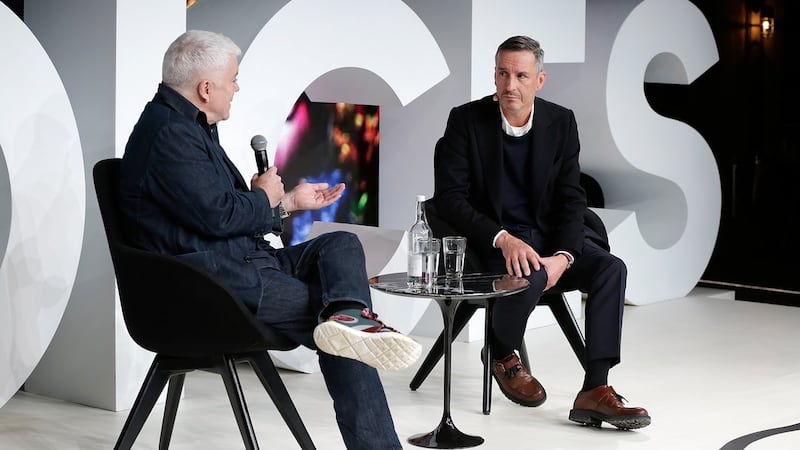
The Business of Fashion
Agenda-setting intelligence, analysis and advice for the global fashion community.

Agenda-setting intelligence, analysis and advice for the global fashion community.

The author has shared a YouTube video.
You will need to accept and consent to the use of cookies and similar technologies by our third-party partners (including: YouTube, Instagram or Twitter), in order to view embedded content in this article and others you may visit in future.
OXFORDSHIRE, United Kingdom — For 30 years, Dries Van Noten has rather consistently charmed fashion insiders and followers alike with his singular point of view, reflected not only in the clothes he designs but also in his decision to remain financially independent.
"Independence is that you don't have to copy an existing business model," the designer said onstage at VOICES, BoF's annual gathering for big thinkers in partnership with QIC Global Real Estate, in an interview with editor-at-large Tim Blanks. "We achieved what we achieved often by coincidence. We grabbed opportunity in an organic way."
It’s an openness — and genuine warmth — that has compelled Van Noten to look outside his own frame of reference for inspiration and information.
“For me, other cultures have always been a starting point. But I never took things very literal. Quite often, we take one element that we like...and mix it to be something very personal,” he said. “It’s like layering. Indian- or African-inspired or ethnic-inspired...it has to be clothes people want to wear now. Clothes that are used to express who they are. To me, that’s the final goal."
Indian- or African-inspired or ethnic-inspired...it has to be clothes people want to wear now. Clothes that are used to express who they are. To me, that's the final goal.
Van Noten’s celebration of cultures other than his own have helped to define the Antwerp, Belgium-based brand. The colour and optimism of Spring 2002 collection, inspired by India and shown in the wake of September 11, 2001, marked a turning point for his business.
“For me, the end of the '90s was a difficult period. My business partner [Christine Mathys] passed away...we were approached by groups. Is this now the way we would have to go? Would we have to put more emphasis on accessories? Would we have to make...cold fashion,” he recalled. “I said, ‘Yeah, okay, no. This is not me.’ I made the collection purely about India, one of my big loves. It was a difficult time...but the strange thing is, our house is always doing good in times of difficulty.”
However, Van Noten acknowledged that the current microscope on cultural appropriation in the fashion industry, fuelled by the openness of the internet, has made referencing other cultures in a way that offends no one nearly impossible to achieve.
“I look now more to the art world, for several reasons,” said the designer, who recently published the tome “Dries Van Noten: 1-100,” which celebrates his first 100 runway shows. “I still make elements and references to ethnic things, but it has become more difficult now.”
For instance, a sweater from his Autumn/Winter 2017 menswear collection, featuring a traditional Peruvian llama motif, incited backlash. “There was a huge reaction against it, that I couldn’t appropriate motifs that have special meaning to people,” he said. “It’s two llamas, I’m sorry, it’s nobody’s property. For me, it’s an iconic garment. It’s such a pity that now we wouldn't be able to use it.”
https://www.instagram.com/p/BX2_imlDpNw
Van Noten likened the restriction to the idea that a Belgian chef could not reference Japanese cooking techniques. “The only ethnicity I could look at is Belgian folklore.… It’s not that I exactly copy them and it's not that I want to hurt people by using certain things,” he said. “It’s the alphabet of fashion, which I use to create my own things. Sometimes, especially with menswear, you have to work with recognisable things. You have to make things that men know.”
I still make elements and references to ethnic things, but it has become more difficult now.
But while other cultures have often been a starting point for the designer, it’s his talent and desire to create something new, always, that has allowed him to maintain relevancy across generations and aesthetic tribes. “You can talk about fashion, you can create fashion, but ultimately the end goal is that people buy the clothes — not only from a commercial perspective...but that people wear the clothes,” he said. “The main goal is that it speaks to a lot of people.”
“We are all citizens of the world,” he added. “For me, it’s an ideal situation.”
To learn more about VOICES, BoF's annual gathering for big thinkers, in partnership with QIC Global Real Estate, visit our VOICES website and click here to request an invitation to attend.
Related Articles:
From analysis of the global fashion and beauty industries to career and personal advice, BoF’s founder and CEO, Imran Amed, will be answering your questions on Sunday, February 18, 2024 during London Fashion Week.
The State of Fashion 2024 breaks down the 10 themes that will define the industry in the year ahead.
Imran Amed reviews the most important fashion stories of the year and shares his predictions on what this means for the industry in 2024.
After three days of inspiring talks, guests closed out BoF’s gathering for big thinkers with a black tie gala followed by an intimate performance from Rita Ora — guest starring Billy Porter.